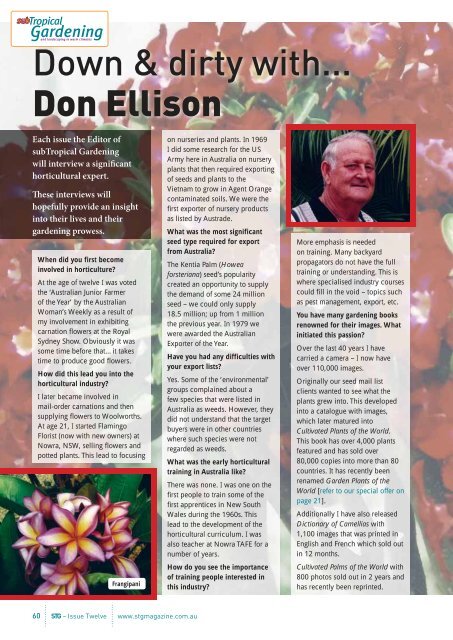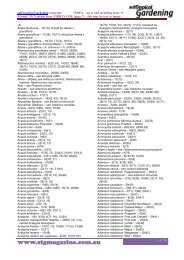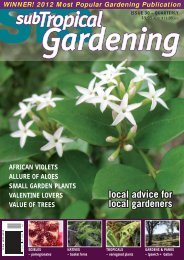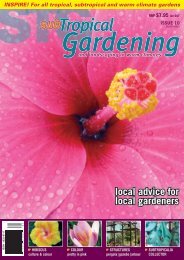Down & dirty with... Don Ellison - subTropical Gardening
Down & dirty with... Don Ellison - subTropical Gardening
Down & dirty with... Don Ellison - subTropical Gardening
Create successful ePaper yourself
Turn your PDF publications into a flip-book with our unique Google optimized e-Paper software.
<strong>Down</strong> & <strong>dirty</strong> <strong>with</strong>...<strong>Don</strong> <strong>Ellison</strong>Each issue the Editor of<strong>subTropical</strong> <strong>Gardening</strong>will interview a significanthorticultural expert.These interviews willhopefully provide an insightinto their lives and theirgardening prowess.When did you first becomeinvolved in horticulture?At the age of twelve I was votedthe ‘Australian Junior Farmerof the Year’ by the AustralianWoman’s Weekly as a result ofmy involvement in exhibitingcarnation flowers at the RoyalSydney Show. Obviously it wassome time before that…it takestime to produce good flowers.How did this lead you into thehorticultural industry?I later became involved inmail-order carnations and thensupplying flowers to Woolworths.At age 21, I started FlamingoFlorist (now <strong>with</strong> new owners) atNowra, NSW, selling flowers andpotted plants. This lead to focusingFrangipanion nurseries and plants. In 1969I did some research for the USArmy here in Australia on nurseryplants that then required exportingof seeds and plants to theVietnam to grow in Agent Orangecontaminated soils. We were thefirst exporter of nursery productsas listed by Austrade.What was the most significantseed type required for exportfrom Australia?The Kentia Palm (Howeaforsteriana) seed’s popularitycreated an opportunity to supplythe demand of some 24 millionseed – we could only supply18.5 million; up from 1 millionthe previous year. In 1979 wewere awarded the AustralianExporter of the Year.Have you had any difficulties <strong>with</strong>your export lists?Yes. Some of the ‘environmental’groups complained about afew species that were listed inAustralia as weeds. However, theydid not understand that the targetbuyers were in other countrieswhere such species were notregarded as weeds.What was the early horticulturaltraining in Australia like?There was none. I was one on thefirst people to train some of thefirst apprentices in New SouthWales during the 1960s. Thislead to the development of thehorticultural curriculum. I wasalso teacher at Nowra TAFE for anumber of years.How do you see the importanceof training people interested inthis industry?More emphasis is neededon training. Many backyardpropagators do not have the fulltraining or understanding. This iswhere specialised industry coursescould fill in the void – topics suchas pest management, export, etc.You have many gardening booksrenowned for their images. Whatinitiated this passion?Over the last 40 years I havecarried a camera – I now haveover 110,000 images.Originally our seed mail listclients wanted to see what theplants grew into. This developedinto a catalogue <strong>with</strong> images,which later matured intoCultivated Plants of the World.This book has over 4,000 plantsfeatured and has sold over80,000 copies into more than 80countries. It has recently beenrenamed Garden Plants of theWorld [refer to our special offer onpage 21].Additionally I have also releasedDictionary of Camellias <strong>with</strong>1,100 images that was printed inEnglish and French which sold outin 12 months.Cultivated Palms of the World <strong>with</strong>800 photos sold out in 2 years andhas recently been reprinted.60 STG – Issue Twelve www.stgmagazine.com.au
Desert Roses (Adenium obesum)Books near completion includeCultivated Exotic Plants featuringover 3,000 images and CultivatedVines and Climbers <strong>with</strong> over2,500 images. These are due tocome out in late 2008 and 2009respectively.With all that knowledge are youcalled upon for public talks?Most talks I give are aboutpromoting Australian native plantsto overseas locations and togarden clubs.Having seen so many plantsaround the world, which 5 plantsdo you believe will be the trendsetters in the next year?• Desert Roses(Adenium obesum)• Caladiums(Caladium xhortulanum)• Cordyline hybrids(Cordyline fruticosa)• Flame tree grafted hybrids(Brachychiton species)• New Thai Hybrid Frangipanis(Plumeria cultivars)What 5 plants are your favouritesin your home garden?• Colville’s Glory(Colvillea racemosa)• Wisteria Tree(Bolusanthus speciosus)• Silk-floss Tree(Chorisia speciosa syn.Ceiba speciosa)• Flaming Beauty(Carphalea kirondron)• Grevillea ‘Golden Lyre’For people moving to a warmclimate, what 5 plants would yourecommend that they try?• Frangipanis (Plumeriaspecies and cultivars)• Desert Roses(Adenium obesum)• Hibiscus(Hibiscus rosa-sinensis)• Tibouchina lepidota‘Alstonville’ and ‘Carol Lyn’• Crotons(Codiaeum variegatum)With all your travels, exportsand imports, what plant are yourSilk-fl oss treemost proud specimens to haveintroduced into Australia?• Duranta ‘Geisha Girl’ dueto its flowers and nonseedinghabit.• Tibouchina ‘Carol Lyn’ alsosold as Tibouchina ‘Jazzie’.Although in ‘semi-retirement’what are you currently doing?I continue to write books <strong>with</strong> myson Anthony, and grow over 50different Passiflora, such as theawesome 12cm wide edible ‘BigBoppa’ passionfruit.Can you name a plant you wouldnever grow again?• Clerodendrumquadriloculare variegatedform – this plant suckersexcessively and maybe weed-like in someconditions. It is best keptin a pot.• Ficus species – all haveinvasive root systems.www.stgmagazine.com.auSTG – Issue Twelve61






